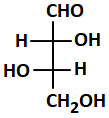Select Chapter Topics:
D(+) glucose yields an oxime with hydroxyl amine. The structure of the oxime would be:
| 1. |  |
2. |  |
| 3. |  |
4. |  |
Subtopic: Carbohydrates - Classification & D-L configuration |
80%
Level 1: 80%+
AIPMT - 2014
Hints
D-Glucose \(\xrightarrow[]{\textbf{?}}\) Saccharic acid
The oxidizing reagent used for this conversion is:
1. HI
2. Bromine water
3. HNO3
4. H2SO4
Subtopic: Polysaccharides & their Importance |
72%
Level 2: 60%+
Hints
Which one is not a D-sugar:
| 1. |  |
2. |  |
| 3. |  |
4. |  |
Subtopic: Carbohydrates - Classification & D-L configuration |
70%
Level 2: 60%+
NEET - 2022
Hints
An anomer is represented by:
| 1. |  |
| 2. |  |
| 3. |  |
| 4. |  |
Subtopic: Carbohydrates - Classification & D-L configuration |
58%
Level 3: 35%-60%
Hints
The incorrect statement among the following regarding glucose is:
| 1. | It is an aldohexose. |
| 2. | n-Hexane is formed when glucose is heating with HI. |
| 3. | It is present in furanose form. |
| 4. | It does not give 2, 4- DNP test. |
Subtopic: Carbohydrates - Classification & D-L configuration |
81%
Level 1: 80%+
Hints
Which one of the following reactions of glucose can be explained only by its cyclic structure?
| 1. | Glucose forms pentaacetate. |
| 2. | Glucose reacts with hydroxylamine to form an oxime. |
| 3. | Pentaacetate of glucose does not react with hydroxylamine. |
| 4. | Glucose is oxidized by nitric acid to saccharic acid. |
Subtopic: Carbohydrates - Classification & D-L configuration |
70%
Level 2: 60%+
Hints
-D-glucose and β-D-glucose are:
1. Epimers
2. Anomers
3. Functional isomers
4. Chain isomers
Subtopic: Carbohydrates - Classification & D-L configuration |
83%
Level 1: 80%+
AIPMT - 2000
Hints
The reagents with which glucose does not react to give the corresponding test/products are:
A. Tollen's reagent
B. Schiff's reagent
C. \(\text{HCN}\)
D. \(\text{NH}_2\text{OH}\)
E. \(\text{NaHSO}_3\)
Choose the correct option:
A. Tollen's reagent
B. Schiff's reagent
C. \(\text{HCN}\)
D. \(\text{NH}_2\text{OH}\)
E. \(\text{NaHSO}_3\)
Choose the correct option:
| 1. | \(\text{A}\) and \(\text{D}\) | 2. | \(\text{B}\) and \(\text{E}\) |
| 3. | \(\text{E}\) and \(\text{D}\) | 4. | \(\text{B}\) and \(\text{C}\) |
Subtopic: Carbohydrates - Classification & D-L configuration |
71%
Level 2: 60%+
NEET - 2024
Hints
The two forms of D-Glucopyranose are called :
1. Anomers
2. Epimers
3. Enantiomers
4. Diastereoisomers
Subtopic: Carbohydrates - Classification & D-L configuration |
80%
Level 1: 80%+
Hints
If a Sugar ' X ' is found in honey, is a keto sugar, exists in \(\alpha\) and \(\beta\) - anomeric forms and is laevorotatory, then find out 'X':
1. Maltose
2. Sucrose
3. D-Glucose
4. D-Fructose
1. Maltose
2. Sucrose
3. D-Glucose
4. D-Fructose
Subtopic: Carbohydrates - Classification & D-L configuration |
59%
Level 3: 35%-60%
NEET - 2025
Please attempt this question first.
Hints
Please attempt this question first.






